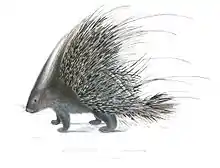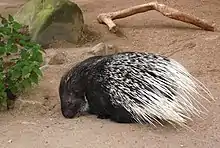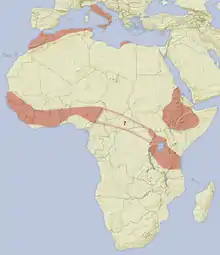Crested porcupine
The crested porcupine (Hystrix cristata), also known as the African crested porcupine, is a species of rodent in the family Hystricidae native to Italy, North Africa and sub-Saharan Africa.[1][2]
| Crested porcupine | |
|---|---|
 | |
 | |
| Crested porcupine in captivity | |
| Scientific classification | |
| Domain: | Eukaryota |
| Kingdom: | Animalia |
| Phylum: | Chordata |
| Class: | Mammalia |
| Order: | Rodentia |
| Family: | Hystricidae |
| Genus: | Hystrix |
| Species: | H. cristata |
| Binomial name | |
| Hystrix cristata | |
 | |
range | |

Characteristics

_Hystrix_cristata.jpg.webp)
The adult crested porcupine has an average head and body length around 60 to 83 cm (24 to 33 in) long, discounting the tail, and weighs from 13 to 27 kg (29 to 60 lb). It is one of the largest rodents in the world.[3]
Almost the entire body is covered with bristles which are either dark brown or black and rather coarse. This mammal is recognizable by the quills that run along the head, nape, and back that can be raised into a crest, hence the name crested porcupine. Also, some sturdier quills which are about 35 cm (14 in) in length run along the sides and back half of the body. These sturdier quills are used, for the most part, for defense and are usually marked with light and dark bands which alternate; these are not firmly attached. This porcupine has a short tail which has rattle quills at the end. The rattle quills broaden at the terminal end and the broad portion is hollow with thin walls. When these quills are vibrated, they produce a hiss-like rattle.
The front feet of the crested porcupine have four developed and clawed digits with a regressed thumb, the rear feet have five. The paws have naked and padded soles and have a plantigrade gait. The ears are external and both the eyes and ears are very small with long vibrissae on its head. The skull is distinctive in many ways: first, the infraorbital foramen is greatly enlarged so portions of the masseter extend through it and attach from the frontal side surface of the snout; second, the angular process is inflected on the lower jaw, and third, the nasal cavity is enlarged. Prominent pockets create enlarged areas of attachment for chewing muscles. Collar bones are very much reduced, and one incisor, one premolar and three molars are present in each quadrant.[4] The male's penis is directed caudally (towards the rear end) when not erect.[5]
Crested porcupines live up to 28 years, the second-longest of any rodent after the naked mole-rat, which can live in excess of 37 years.[6][7]
Distribution and habitat
The crested porcupine is found in Italy, North Africa, and sub-Saharan Africa. In the Mediterranean, it is known from mainland Italy and the island of Sicily, Morocco, Algeria, and Tunisia; they are also recorded in Ghana, Libya and along the Egyptian coast. It has been recorded from sea level to 2,550 m (8,370 ft) in Moroccan Anti-Atlas. The crested porcupine is thought to have been introduced to Italy in the Late Antique/early medieval period.[8]


The crested porcupine is native to Algeria, Benin, Burkina Faso, Burundi, Cameroon, Central African Republic, Chad, Côte d'Ivoire, Democratic Republic of the Congo, Eritrea, Ethiopia,[9] Gambia, Ghana, Djibouti, Guinea, Guinea-Bissau, Kenya, Liberia, Libya, Mali, Mauritania, Morocco, Nigeria, Rwanda, Senegal, Sierra Leone, Somalia, Sudan, South Sudan, Tanzania, Togo, Tunisia and Uganda.[8] It may be locally extinct in Egypt.
Behaviour and ecology
The crested porcupine is a terrestrial mammal; it very seldom climbs trees, but can swim. It is nocturnal and monogamous. The crested porcupine takes care of the young for an extended period, and small family groups consist of the adult pair and young of various ages. In defense, when disturbed, they raise and fan their quills to make themselves look bigger. If continually bothered, the crested porcupine will stamp its feet, whirr the quills, and charge the disturber back end first trying to stab the enemy with the thicker, shorter quills. These attacks are known to have killed lions, leopards, hyenas, and even humans.[4]
Crested porcupines have been known to collect thousands of bones that they find at night. They are mostly nocturnal, and they may come upon the skeletons of animals. They collect these bones and store them in an underground chamber or cave.[10]
Diet and digestion
The crested porcupine is for the most part herbivorous, eating roots, bulbs, and leaves, but occasionally they do consume insects, small vertebrates, and carrion. To ingest calcium and sharpen incisors, they often gnaw on bones. These animals often travel long distances looking for food. They have high crowned teeth that grind plant tissues which are digested in the stomach, and the undigested fibers are retained in an enlarged appendix and anterior large intestine, where they are broken down by microorganisms.
Reproduction
Most of what is known about reproduction in the crested porcupine comes from individuals in captivity. Usually, female crested porcupines have one litter every year. One or two well developed young are born in a chamber within the burrow that is usually lined with grass, after on average a 66-day gestation period. The young weigh about 1,000 g (2.2 lb) at birth, which is about 5% of the mother's weight. They leave the den after one week. At this time, the spines begin to harden. Crested porcupines reach adult weight at one to two years and are often sexually mature just before then.[4] Breeding occurs throughout the year.[11]
Local and indigenous names
- In Italian: porcospino or istrice
- In the Tigrinya language: ቅንፈዝ (qinfiz)[9]
- In Amharic: jart
- In the Akan language: kotoko
- In the Oromo language: xadddee
References
- Amori, G. & De Smet, K. (2016). "Hystrix cristata". IUCN Red List of Threatened Species. 2016: e.T10746A22232484. doi:10.2305/IUCN.UK.2016-2.RLTS.T10746A22232484.en. Retrieved 19 November 2021.
- Wilson, D. E.; Reeder, D. M., eds. (2005). "Species Hystrix (Hystrix) cristata". Mammal Species of the World: A Taxonomic and Geographic Reference (3rd ed.). Johns Hopkins University Press. p. 1543. ISBN 978-0-8018-8221-0. OCLC 62265494.
- van Aarde, Rudi (1984). Macdonald, D. (ed.). The Encyclopedia of Mammals. New York: Facts on File. pp. 704–705. ISBN 978-0-87196-871-5.
- McPhee, M. (2003). "Hystrix cristata". Animal Diversity Web.
- Atalar, O.; Ceribasi, A. O. (2006). "The morphology of the penis in porcupine (Hystrix cristata)" (PDF). Veterinární Medicína. 51 (2): 66–70. doi:10.17221/5520-VETMED.
- Buffenstein, Rochelle; Craft, Wendy (2021). "The Idiosyncratic Physiological Traits of the Naked Mole-Rat; a Resilient Animal Model of Aging, Longevity, and Healthspan". Advances in Experimental Medicine and Biology. Cham: Springer International Publishing. p. 246. doi:10.1007/978-3-030-65943-1_8. ISBN 978-3-030-65942-4. ISSN 0065-2598.
- Ruby, J Graham; Smith, Megan; Buffenstein, Rochelle (24 January 2018). "Naked mole-rat mortality rates defy Gompertzian laws by not increasing with age". eLife. eLife Sciences Publications, Ltd. 7. doi:10.7554/elife.31157. ISSN 2050-084X. PMC 5783610.
- Masseti, M.; Albarella, U. & De Grossi Mazzorin, J. (2010). "The crested porcupine, Hystrix cristata L., 1758, in Italy" (PDF). Anthropozoologica. 45 (2): 27–42. doi:10.5252/az2010n2a2. S2CID 130452325.
- Aerts, R. (2019). "Forest and woodland vegetation in the highlands of Dogu'a Tembien". In Nyssen J.; Jacob, M.; Frankl, A. (eds.). Geo-trekking in Ethiopia's Tropical Mountains - The Dogu'a Tembien District. SpringerNature. ISBN 978-3-030-04954-6.
- Coppola, F.; Guerrieri, D.; Simoncini, A.; Varuzza, P.; Vecchio, G.; Felicioli, A. (2020). "Evidence of scavenging behaviour in crested porcupine". Scientific Reports. 10 (1): 12297. Bibcode:2020NatSR..1012297C. doi:10.1038/s41598-020-69252-z. PMC 7378177. PMID 32704027.
- Felicioli, A.; Grazzini, A.; Santini, L. (1997). "The mounting and copulation behaviour of the crested porcupine Hystrix cristata". Italian Journal of Zoology. 64 (2): 155–161. doi:10.1080/11250009709356189.
